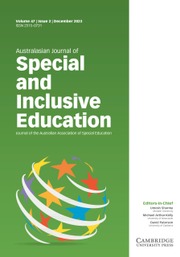Article contents
Multiplayer Games: Multimodal Features That Support Friendships of Students With Autism Spectrum Disorder
Published online by Cambridge University Press: 01 August 2019
Abstract
There is an absence of research into online friendships and video gaming activities of students with autism spectrum disorder (ASD). In this article we describe how friendships of students with ASD were developed in an online multiplayer context using the popular sandbox game, Minecraft. Multimodal analysis of the data demonstrated that online multiplayer gaming supported students’ use of speech to engage in conversations about their friendships, and to share gaming experiences with their offline and online friends. Online gaming enabled students to visually gather information about their friends’ online status and activities, and to engage in the creative and adventurous use of virtual images and material representations with friends. Despite the benefits for friendships, students with ASD experienced difficulties in friendships in multimodal ways. Notably, students engaged in verbal disagreements about video gaming discourses, sought out activities associated with the themes of death and damage using written text, and tended to dominate shared creations of virtual images and their representation. The findings have implications to better support the friendships of students through inclusive literacy practices online.
Keywords
Information
- Type
- Original Articles
- Information
- Australasian Journal of Special and Inclusive Education , Volume 43 , Issue 2 , December 2019 , pp. 69 - 82
- Copyright
- © The Author(s) 2019
Footnotes
This manuscript was accepted under the Editorship of Umesh Sharma.
References
- 5
- Cited by

